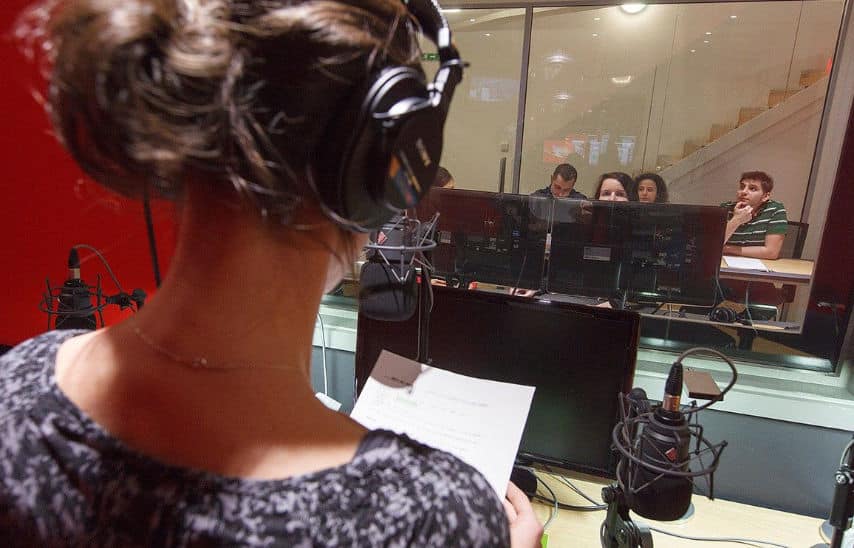In today’s globalised entertainment landscape, the ability of film to cross cultural and linguistic barriers is not just a marvel—it’s an imperative. In an age where digital platforms have dissolved geographic boundaries, a film produced in one corner of the world is as accessible as one made thousands of miles away. Yet, accessibility does not automatically equate to comprehension or enjoyment. This is where the pivotal role of film translation and localisation comes into play, transforming a regional story into a global phenomenon.
The significance of film translation in this boundless entertainment terrain cannot be understated. It is the bridge that connects disparate audiences, the interpreter of narratives, and the enabler of cultural exchange. Through the meticulous process of translation, films carry the potential to reach a diverse viewership, each member sitting before the screen, ready to be immersed in the visual storytelling that unfolds regardless of the language spoken.
But translation extends beyond the mere conversion of text; it is an art that demands a profound sensitivity to the subtleties of language and culture. A well-localised film resonates with audiences in a way that feels native, never foreign. The laughter, the pathos, the suspense—all the fundamental human emotions that cinema evokes—are felt universally when the art of film localisation is mastered.
As we embark on this exploration of how to translate film, we’ll discover the intricacies of this art form. From the crafting of subtitles to the nuances of dubbing, and the descriptive power of audio narration, each plays a crucial role in ensuring that a film can speak to audiences across the globe. These are the threads that, when woven together with skill and care, create a tapestry of shared experience—a cinematic work that can be appreciated by anyone, anywhere, without the barrier of language standing in the way.
Table of Contents
ToggleHow to Translate Film – Exploring Your Options
Subtitling: The First Step in Film Translation
Subtitling serves as the cornerstone of film translation, offering an essential bridge for audiences to cross linguistic divides and engage with foreign-language cinema. This mode of translation is not just about rendering speech into text; it’s an art that combines linguistic dexterity with cultural intelligence, ensuring that viewers are not merely spectators but participants in the narrative journey.
The process of subtitling begins with transcription, a meticulous exercise where every utterance, meaningful sound, and musical nuance is transcribed. This transcript is the blueprint from which the subtitles are crafted. It must be precise, capturing not only the words but also the rhythm and pacing of the dialogue, and the subtleties of sound that are often overlooked, yet critical for setting context and mood.
Once the transcript is ready, the translation phase commences. This is where the challenge of conciseness meets the demand for clarity. Translators must navigate the intricacies of the source language and transpose them into the target language without diluting the film’s original tone or diluting its emotional impact. They operate within spatial and temporal constraints, distilling dialogue into succinct subtitles that convey the same message within the fleeting timeframe that the scene allows.
Timing is a critical aspect of subtitling. The emergence and disappearance of each line of text must be synchronised with the actors’ delivery to facilitate a natural reading rhythm. Precision in timing ensures that audiences remain engaged with the on-screen action without being jolted by delayed or premature subtitles that can disrupt the flow of storytelling.
Moreover, the art of subtitling lies in the ability to convey the film’s original message with fidelity. This means grappling with cultural references, idioms, and humour that do not always have a direct counterpart in the target language. The skill lies in finding a balance—localising content without losing the essence of the message. It’s a tightrope walk between remaining true to the source material and adapting it for cultural relevance and comprehension.
In crafting subtitles, every decision, from the choice of words to the duration and timing of their appearance, contributes to the audience’s understanding and enjoyment of the film. The precision in this process is paramount; it ensures that the film’s heart—its message, its wit, its emotional core—is not lost in translation but shared universally. Thus, subtitling is more than a first step; it is a foundational component of film translation that upholds the narrative’s integrity for viewers around the world.
Dubbing: Enhancing the Film Translation Experience
Dubbing is a translation technique that can profoundly enhance viewer engagement and enjoyment by providing a fully immersive auditory experience. This method involves replacing the original dialogue with a voice track in the target language, synchronised to the actors’ lip movements and on-screen actions. It allows audiences to concentrate entirely on the visual storytelling without dividing their attention between reading subtitles and watching the film.
The process of dubbing is complex and demands an integration of technical skill, creative sensitivity, and precise execution. It begins with the adaptation of the screenplay into the target language. This adaptation is not a word-for-word translation; it requires a nuanced understanding of the film’s dialogue to maintain the original pacing, tone, and emotional impact. Translators must create a script that aligns with the characters’ mouth movements—a process known as lip-syncing—which often necessitates inventive linguistic solutions to match the lip patterns and expressions of the on-screen actors.
Casting the right voice talent is critical to the dubbing process. The voice actors must be fluent in the target language and possess the ability to convey the original characters’ emotional range. They are tasked with interpreting the performance of the original actors, capturing their essence, and delivering it in a new language. This requires not only vocal talent but also an actor’s intuition to embody the characters’ personalities and nuances, ensuring the dub feels natural and authentic.
The recording stage is where the translated script and voice talent come together. In a studio, the voice actors perform their lines, often with the original film playing in the background for reference. Directors and sound engineers collaborate closely, guiding the actors to match the timing and intonation of the original performances. The goal is to create a synchronicity that allows the new audio track to blend seamlessly with the visual elements of the film.
Expertise in the recording phase is essential. Sound engineers must balance the dubbed dialogue with the film’s existing soundtrack, ensuring that all elements coalesce into a harmonious auditory experience. They fine-tune the voice recordings, adjusting the pitch, tempo, and volume to mirror the natural flow of the original language track. The intricacies of sound design, such as background noises and diegetic sounds, are also meticulously integrated, preserving the film’s atmosphere and setting.
The final product of a well-executed dubbing process is a film that speaks to its new audience as authentically as it did to its original one. The voices resonate with the viewers’ cultural and linguistic expectations, allowing for a cinematic experience that is both accessible and engaging. Through dubbing, a film transcends its original language, becoming a global work of art that connects with audiences on a visceral level, creating a shared experience that is both universal and deeply personal.
Comprehensive Accessibility: Subtitling, Dubbing, and Audio Description
In the realm of film translation, the pursuit of comprehensive accessibility is an integrated approach that combines subtitling, dubbing, and audio description to cater to the diverse needs of a global audience. This triad of services ensures that films are not only accessible across different languages but also to viewers with varying sensory requirements, thus embracing the full spectrum of inclusivity.
Subtitling is the visual component of this accessibility package, providing a textual representation of the spoken dialogue and auditory cues on screen. It’s a service that benefits not just those who are hearing-impaired but also viewers who prefer or require visual aids to understand the film in a language other than their own. The art of subtitling lies in concisely capturing the essence of dialogue and translating cultural nuances without disrupting the flow of the film.
Dubbing, on the other hand, offers an auditory translation, replacing the original audio with a new track in the viewer’s language. It allows for a seamless viewing experience, particularly beneficial for children, the visually impaired, or others who may find reading subtitles challenging while trying to engage with the visual aspects of a film. The goal of dubbing is to provide a localised version of the movie where the voice acting resonates as naturally as the original performances.
Audio description is a narrative service that fills the visual gaps for those who are blind or visually impaired. A narrator describes the visual elements of the film—such as actions, gestures, scenes, and on-screen text—during natural pauses in the audio. This description provides context and enhances the storytelling, allowing all viewers to appreciate the film’s full depth, including its visual subtleties and aesthetic qualities.
The integration of these services into a single package ensures that the film can reach the widest audience possible. Subtitling enables viewers to read the dialogue and understand the content without knowing the original language. Dubbing allows for an immersive experience where the language barrier is removed through voice. Audio description adds a layer of inclusivity, ensuring that those who cannot rely on visual cues are not excluded from the cinematic experience.
This comprehensive approach to film translation and localisation demonstrates a commitment to accessibility in its truest form. By offering these extensive services, the aim is to provide an equal viewing experience for all, regardless of language proficiency or sensory abilities. It embodies the principle that film, as a universal art form, should be available and enjoyable to everyone, everywhere—without exception.
Choosing Languages to Translate Your Film
Beyond the Top 10: Tailoring Language Selection
Selecting languages for film translation extends well beyond simply picking from the roster of the world’s most spoken languages. While the top 10—typically including Mandarin, Spanish, English, Hindi, Arabic, Portuguese, Bengali, Russian, Japanese, and Punjabi—represent significant global demographics, they are not automatically the best choice for every film’s translation strategy.
Strategic language selection is essential when planning to translate film content. It involves a nuanced approach that takes into account not just the number of speakers but also market-specific factors such as cultural relevance, local content preferences, and the presence of potential distribution networks. This tailored approach ensures that the film resonates with the intended audience and achieves maximum impact.
For instance, a film with regional cultural elements might find a passionate audience in languages that do not make it to the global top 10 but have a strong regional presence. Likewise, a niche genre film might perform better in a language spoken by a smaller audience that, nonetheless, has a high demand for that genre.
The assistance in identifying the right languages for a film’s target audience is a nuanced process. It requires an understanding of both the film’s content and its potential international audience. Market research, understanding of cultural trends, and audience analysis are all pivotal in making an informed decision. The goal is to align the film’s narrative with the languages of viewers who are most likely to embrace it, ensuring the film finds a welcoming audience ready to connect with its story.
By considering these aspects, the translation process becomes less about casting a wide net with the top 10 languages and more about fishing in the right waters, where the film is likely to catch the current of cultural connectivity and viewer engagement. This strategic selection is crucial for the film to not only reach audiences across linguistic barriers but to resonate with them on a deeper, more meaningful level.
The Process to Translate Film
Transcription: The Starting Line in How to Translate Film
Transcription is the first and crucial step in the film translation process, serving as the foundation upon which all subsequent translation efforts are built. This phase involves creating a detailed written record of the film’s audio track, including dialogue, voice-overs, and non-verbal auditory cues such as laughter, sighs, and significant sound effects. It’s a step that demands precision and an astute ear, as the transcription forms the bedrock of accuracy for all the translations that follow.
The role of transcription in preparing a film for translation is multifaceted. Firstly, it provides a clear, accurate script for translators to work from, ensuring that no aspect of the original dialogue is missed or misinterpreted. It also aids in the timing and pacing of subtitles and dubbing, as a precise transcription will include time codes that pinpoint when a line is spoken. These time codes are critical for synchronising subtitles and dubbed audio with the spoken dialogue in the film.
A meticulous approach to transcription is non-negotiable. It requires transcribers to capture every nuance of the spoken word, as well as contextual sounds that may influence how dialogue is perceived. For instance, the tone of a character’s voice, the background noise, and the cadence of speech can all affect meaning and must be noted in the transcription. Moreover, capturing the exact phrasing and slang used is crucial for accurate translation, especially when the dialogue includes colloquialisms, technical jargon, or culturally specific references.
Transcribers must be skilled listeners and typists, often fluent in the language of the original film and familiar with its cultural context to ensure that nothing is lost in the written record. The transcription process often involves several revisions to check for accuracy, consistency, and completeness. It’s a task that requires patience and attention to detail, as the quality of the transcription directly impacts the quality of the final translated product.
Translation: The Core of Film Translation
At the heart of film translation lies the intricate process of translating the script, an endeavour that goes well beyond the mere exchange of words from one language to another. This pivotal stage involves delving into the script’s complexities and subtleties, ensuring that every line, every cultural reference, and every nuanced expression is carried over into the target language while keeping the original context intact.
The complexities of translating a film script arise from the need to maintain the film’s original tone, pace, and narrative structure. Dialogue in film is often laden with idiomatic expressions, regional slang, humour, and cultural references that may not have direct equivalents in other languages. The translator must navigate these challenges, finding ways to convey the same meaning and emotional impact in the target language. It requires a deep understanding of both the source and target cultures, as well as the ability to write dialogue that feels authentic and maintains the characters’ voices.
To honour the film’s original tone and narrative, translation services employ linguists and translators who specialise in literary and cinematic texts. These professionals bring a sensitivity to the translation process that goes beyond basic fluency. They must interpret the intention behind each line and recreate it in a way that resonates with the new audience while respecting the film’s artistic integrity.
This process often involves creative problem-solving. For instance, when a joke relies on wordplay that doesn’t translate directly, the translator must find an equivalent that elicits the same response from the new audience. Similarly, when characters use dialect or jargon, the translator must choose appropriate alternatives that preserve the character’s unique voice without alienating viewers unfamiliar with the original language.
Furthermore, translation for film involves collaborative rounds of editing and proofreading to ensure that the translated script is as polished as the original. It’s a task that requires not only linguistic skills but also a collaborative spirit, as translators work with editors, directors, and sometimes even the original scriptwriters to ensure that the translated script aligns with the film’s vision.
Voice Talent: The Final Touch in How to Translate Film
The selection of voice actors stands as the final, yet pivotal, touch in the film translation process, especially when dubbing is the chosen method. It is a critical phase that can define a dubbed film’s success, as the voice talent brings a new linguistic dimension to the characters, imbuing them with life and resonance in the target language.
The importance of selecting the right voice actors cannot be underestimated. They are tasked with the delicate job of recreating the original actors’ performances in a way that is authentic to the target culture while preserving the intention, emotion, and personality of each character. A well-cast voice can bridge the gap between the audience and the character, creating a sense of familiarity and emotional connection, even in a foreign language.
To match voice talent with film characters, a comprehensive casting process is undertaken. This involves several key steps to ensure the voices chosen for the dubbing are in harmony with the characters they represent. Initially, casting directors carefully review the original performances, noting the specific qualities of each character’s voice — their tone, pitch, cadence, and emotional range. Then, they compile a profile for each character that serves as a benchmark during the casting process.
Voice actors are selected based on their ability to match these profiles. They must be able to replicate the essence of the original actor’s voice while also making the performance their own. This requires not only vocal range and acting skills but also an understanding of the character’s arc and the story’s overall tone. Auditions often involve reading lines from the script, allowing casting directors to hear how the actors’ voices fit with the characters and how well they can convey the necessary emotions and nuances.
Once the voice actors are chosen, they work closely with directors and sound engineers to refine their performances. The dubbing process is highly collaborative, with voice actors often recording their lines while watching the original scenes, ensuring their delivery is in sync with the characters’ lip movements and on-screen actions. Directors guide the actors to match the timing and inflection of the original lines, adjusting performances to capture the film’s rhythm and pacing correctly.
The challenge is not just in mimicking the original voice but in recreating the character’s full emotional depth. This might involve adjusting line deliveries to suit cultural nuances or preferences of the target audience, which can differ from the original. For example, a character’s humorous line might require a different delivery style to resonate with the new audience, or a dramatic monologue might need to be tempered to align with cultural sensibilities.
The Cost to Translate Film
Understanding the Investment in Film Translation
Translating a film is a significant undertaking that requires a well-orchestrated blend of linguistic skills, technical expertise, and creative insight. Understanding the cost associated with this process is crucial for filmmakers, as it represents a substantial investment in making their work accessible and appealing to a global audience.
The cost to translate a film is influenced by several key factors:
Length and Complexity of the Film: Naturally, the longer and more complex the film, the higher the cost of translation. A feature-length film with intricate dialogues and numerous characters will require more extensive translation efforts compared to a short film with simpler content.
Translation Method: The chosen method of translation – be it subtitling, dubbing, or a combination including audio description – significantly affects the cost. Dubbing, for instance, is typically more expensive than subtitling due to the need for voice actors and recording facilities. Audio description adds an additional layer of complexity and cost, requiring skilled narrators and careful synchronization with the film’s visuals.
Number of Languages: The more languages into which the film is translated, the higher the overall cost. Each additional language translation involves separate translation, adaptation, and possibly dubbing efforts.
Cultural Localization and Adaptation: Films often contain cultural references, idioms, or humor that may not directly translate into other languages. Adapting these elements for different cultures can be a complex task, requiring specialized knowledge and sometimes creative rewriting, which can add to the cost.
Quality and Experience of Translators: The expertise of the translators and voice actors plays a crucial role in the translation process. Experienced professionals who specialize in film translation generally command higher fees, but their expertise ensures accuracy and cultural sensitivity, which are critical for the film’s success in international markets.
Technical Requirements: For dubbing, there are technical costs involved, including studio time for recording and costs associated with mixing and mastering the audio. For subtitling, technical considerations include the text’s formatting and integration into the film, ensuring that subtitles are timed accurately and are easy to read.
A commitment to providing value for money in film translation services involves striking a balance between cost-effectiveness and high-quality translation. This means employing efficient translation processes, leveraging technology where appropriate, and working with skilled professionals who can deliver accurate and culturally resonant translations. The goal is to ensure that the translated film retains the original’s essence, engages the target audience, and justifies the investment made in its translation.
Understanding these cost factors allows filmmakers and production companies to budget appropriately for the translation process and make informed decisions about how best to adapt their work for international audiences. It’s an investment that can significantly expand a film’s reach and impact, making the cost a crucial consideration in the broader context of the film’s global distribution and reception strategy.
Best Practices in Film Translation
Assuring Quality in How to Translate Film
Ensuring quality in film translation is a multifaceted process that involves several best practices and quality assurance protocols. These practices are essential to maintain the integrity of the original film while making it accessible and engaging for new audiences.
Comprehensive Script Analysis: Before any translation begins, a thorough analysis of the script is crucial. This involves understanding the context, setting, characters, and plot to ensure that translations are accurate and maintain the narrative’s flow.
Employing Expert Translators: The translators’ expertise in both the source and target languages, as well as their understanding of film language, is vital. Employing translators who specialize in cinematic content ensures that they can aptly handle dialogues, idioms, and cultural nuances.
Cultural Sensitivity and Localization: Translation isn’t just linguistic but also cultural. Best practices include adapting cultural references, humor, and idioms so they resonate with the target audience. This might involve replacing a region-specific reference with one more familiar to the new audience, without altering the original intent.
Quality Assurance Checks: Multiple rounds of revisions and proofreading are essential. This involves checking for linguistic accuracy, cultural appropriateness, and consistency throughout the film.
Synchronization and Timing in Subtitles and Dubbing: For subtitling, ensuring the text aligns with the spoken dialogue is crucial for viewer comprehension. In dubbing, the voice actors’ speech must be synchronized with the characters’ lip movements, requiring precise timing and voice acting.
Collaboration with Directors and Writers: Involving the original directors or writers can be beneficial, especially when translating nuanced content. Their insights can guide the translation to remain true to the film’s vision.
Regular Training and Updates for Translators: Keeping translators up-to-date with the latest trends in language and culture, as well as advancements in translation technology, is essential for maintaining high standards.
Cultural Adaptation and Compliance in Film Translation
Navigating cultural adaptation and compliance in film translation is a critical aspect of reaching diverse markets.
Understanding Cultural Context: Deep knowledge of the target culture is essential to ensure the film resonates with the audience. This might involve research into local customs, traditions, and societal norms.
Adapting Content for Cultural Sensitivities: Films should be adapted to respect cultural sensitivities and avoid potential controversies. This might involve altering or omitting certain scenes or dialogues that may be inappropriate in certain cultures.
Compliance with Local Regulations: Being aware of and complying with local broadcasting and censorship regulations is crucial. This includes understanding limitations regarding language, violence, sexual content, and political or religious references.
Engaging Cultural Consultants: Involving cultural consultants can provide valuable insights into the target culture, helping to adapt the content in a way that is respectful and appropriate.
Feedback from Local Audiences: Testing the translated film with local focus groups can provide feedback on cultural appropriateness and audience engagement, allowing for adjustments before final release.
These best practices in film translation, focusing on quality assurance and cultural adaptation, are key to ensuring that the translated film maintains the original’s essence while being relevant and respectful to the new audience. This approach not only enhances the film’s appeal in diverse markets but also contributes to a more inclusive and culturally sensitive global film industry.
Success Stories in Film Translation
GoLocalise’s Portfolio: Translating Films for Global Success
GoLocalise has established itself as a leader in film translation, contributing to the international success of numerous films through its expert services. This section highlights some of their most notable success stories and case studies, showcasing the impact of their work in bringing films to a global audience.
Independent Feature Film Translation and Localization: One of GoLocalise’s standout projects involved working on an independent feature film, originally produced in Spanish. The film, rich in cultural nuances and regional idioms, presented a challenge in translating not only the language but also the cultural essence. GoLocalise employed a team of expert translators and cultural consultants who worked meticulously to adapt the script, preserving the film’s original charm and humor. The film was successfully dubbed into English, French, and German, and received acclaim in film festivals across Europe and North America, significantly widening its audience.
Animated Movie Dubbing and Subtitling: GoLocalise took on a project for an animated movie that needed to appeal to younger audiences across various regions. Recognizing the importance of matching voice actors to the animated characters, GoLocalise conducted extensive casting to find the perfect fit for each role. The team also worked closely with animation studios to ensure lip-sync accuracy. The movie was dubbed into five languages, including Mandarin and Arabic, and subtitled in ten more. The translated versions maintained the original’s vibrancy and humor, making the movie a hit with children and families worldwide.
Documentary Film Localization for Global Distribution: GoLocalise worked on a documentary film that explored global environmental issues. The project required not just translation, but the sensitive handling of various dialects and technical jargon related to environmental science. The team at GoLocalise provided subtitles in multiple languages, including less commonly spoken ones, expanding the documentary’s reach to audiences in remote regions, which was crucial for the film’s message.
Historical Drama Series Dubbing: A historical drama series presented a unique challenge due to its period-specific dialogue and context. GoLocalise’s team undertook thorough research to understand the historical context, ensuring the translation was accurate and period-appropriate. The series was dubbed into four major languages, receiving praise for its authenticity and attention to detail, which was pivotal in engaging audiences unfamiliar with the historical setting.
These case studies from GoLocalise’s portfolio demonstrate their capability to handle a diverse range of film translation projects. Each project highlights their commitment to quality, cultural sensitivity, and an in-depth understanding of the target audience. Through their work, GoLocalise has not only helped films reach wider audiences but has also contributed to the promotion of cultural exchange and understanding through cinema.
FAQs
What are the essential services provided in film translation?
Essential services in film translation encompass subtitling, dubbing, and audio description. These services ensure that films are not only linguistically accessible but also culturally resonant and engaging for global audiences. Subtitling provides written translations of the dialogue, dubbing offers voice-over in different languages, and audio description narrates visual elements for visually impaired viewers.
How is the quality of film translations ensured?
Ensuring the quality of film translations involves a multi-layered approach. It starts with employing expert translators who are not only proficient in the language but also understand film-specific nuances. The translation process includes thorough script analysis, careful adaptation to account for cultural differences, and rigorous quality assurance checks. This comprehensive approach ensures translations are accurate, culturally sensitive, and consistent with the original film’s tone and intent.
Can GoLocalise translate films into multiple languages?
Absolutely, GoLocalise specialises in translating films into multiple languages. This process is managed by their team of expert linguists and translators, each proficient in their respective languages. GoLocalise understands the complexities involved in maintaining a film’s essence across various translations. They focus not only on linguistic accuracy but also on the cultural subtleties and nuances specific to each target language. Their goal is to ensure the film remains accessible and engaging for a diverse international audience, preserving the original narrative and emotional impact for viewers worldwide.
What factors make a film translation service stand out?
A film translation service stands out based on its commitment to accuracy, cultural sensitivity, and its ability to capture the original film’s essence. Key factors include a team of experienced translators, the use of advanced translation tools and techniques, and a deep understanding of film language and storytelling. Additionally, the ability to tailor services to meet the specific needs of different genres and audiences is crucial for a translation service’s success.
What is the typical timeframe for translating a film?
he timeframe for translating a film varies depending on several factors, including the length of the film, the complexity of the content, and the number of languages into which it is being translated. Typically, a comprehensive translation process involves script analysis, translation, quality checks, and final adjustments, all of which can impact the overall timeline. Clients are usually provided with an estimated schedule based on their specific project requirements.
Is it possible to tailor film translations for specific international markets?
Yes, film translations can be specifically tailored for particular international markets. This process involves understanding the cultural context and preferences of the target market. Translators and cultural experts work together to ensure that the film resonates with local audiences, considering aspects like cultural references, societal norms, and local humor. This targeted approach helps in making the film more relatable and successful in the chosen market.
Do translation services cater to independent filmmakers?
Translation services often cater to a wide range of clients, including independent filmmakers. These services understand the unique challenges and constraints of independent film projects and offer flexible, customized solutions. Whether it’s a limited budget or a need for a specific language or cultural adaptation, translation services can provide the necessary support to help independent films reach a broader audience.






















